Flora Antarctica
The Flora Antarctica or formally and correctly The Botany of the Antarctic Voyage of H.M. Discovery Ships Erebus and Terror in the years 1839–1843, under the Command of Captain Sir James Clark Ross, is a description of the many plants discovered on the Ross expedition, which visited islands off the coast of the Antarctic continent, with a summary of the expedition itself, written by Joseph Dalton Hooker and published in parts between 1844 and 1859 by Reeve Brothers in London.[1] Hooker sailed on HMS Erebus as assistant surgeon.[2]
 Title page with an etching of Victoria Barrier with Mount Erebus and Mount Terror; one of the expedition's ships is shown temporarily trapped in sea ice. | |
| Author | Joseph Dalton Hooker |
|---|---|
| Illustrator | Walter Hood Fitch |
| Country | England |
| Language | English |
| Series | Monthly parts |
| Subject | Botany |
| Publisher | Reeve Brothers |
Publication date | 1843 – 1859 |
| Text | Flora Antarctica at Wikisource |
The botanical findings of the Ross expedition were published in four parts, the last two in two volumes each, making six volumes in all:
- Part I Flora of Lord Auckland and Campbell's Islands (1843–45)
- Part II Flora of Fuegia, the Falklands, Kerguellen's land, etc (1845–47)
- Part III Flora of New Zealand (1851–53) (2 vols)
- Part IV Flora of Tasmania (1853–59) (2 vols)
All were "splendidly" illustrated by Walter Hood Fitch.[3] The larger part of the plant specimens collected during this expedition are now part of the Kew Herbarium.[4]
Although Hooker professed not to have changed his views on Darwin's theory of evolution by natural selection, the Flora of Tasmania contains an introductory essay on biogeography written from a Darwinian point of view, making the book the first case study for the theory.
Context
.jpg)
The British government fitted out an expedition led by James Clark Ross to investigate magnetism and marine geography in high southern latitudes, which sailed with two ships, HMS Terror and HMS Erebus on 29 September 1839 from Chatham.
The ships docked at Madeira, Tenerife, the Cape Verde archipelago, Saint Peter and Saint Paul Archipelago, Trinidad to arrive at the Cape of Good Hope on 4 April 1840. On 21 April the giant kelp Macrocystis pyrifera was found off Marion Island, but no landfall could be made there or on the Crozet Islands due to the harsh winds. On 12 May the ships anchored at Christmas Harbour for two and a half months, during which all plants previously encountered by James Cook on the Kerguelen Islands were collected. On 20 July they sailed again to arrive on 16 August at the River Derwent, to remain in Tasmania until 12 November. A week later the flotilla stopped at Lord Auckland's Islands and Campbell's Island for the spring months.
Large floating forests of Macrocystis and Durvillaea were found until the ships run into the icebergs at latitude 61° S. Pack-ice was met at 68° S and longitude 175°. During this part of the voyage Victoria Land, Mount Erebus and Mount Terror were discovered. After returning to Tasmania for three months, the flotilla went via Sydney to the Bay of Islands, and stayed for three months in New Zealand to collect the plants.
From 6 April 1842 a long stay in the Falklands began, where the flora was investigated to supplement the work of Admiral D’Urville and of the crew of the Uranie. When visiting the Hermite Islands, seedlings of the deciduous Nothofagus antarctica and the evergreen Nothofagus betuloides were collected from this southernmost location of any tree. These were planted on the Falklands, and some were later brought to Kew. Other plants were also collected. On Cockburn’s Island twenty cryptogam species were found. The ships returned to the Cape of Good Hope on 4 April 1843. At the end of the journey specimens of some fifteen hundred plant species had been collected and preserved.[5]
Reception
Joseph Dalton Hooker gave Charles Darwin a copy of (a draft of) the Flora; Darwin thanked him, and agreed in November 1845 that the geographical distribution of organisms would be "the key which will unlock the mystery of species".[6]
The book remains important; for example, in 2013 W. H. Walton in his Antarctica: Global Science from a Frozen Continent describes it as "a major reference to this day", encompassing as it does "all the plants he found both in the Antarctic and on the sub-Antarctic islands", surviving better than Ross's deep-sea soundings which were made with "inadequate equipment".[7]
Monograph
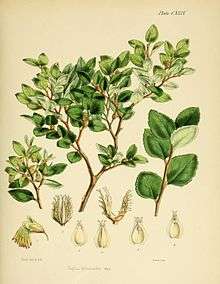
The four parts of the Flora Antarctica total 6 volumes, describe about 3000 species, and contain 530 plates which figure 1095 of the species.
Flora of Lord Auckland and Campbell's Islands
Part I, published between 1843 and 1845, covers the Flora of Lord Auckland and Campbell's Islands. It has 208 pages, 370 species, 80 plates and map, and figures 150 species.
Flora of Fuegia, the Falklands, Kerguellen's land, etc.
Part II, published between 1845 and 1847, covers the Flora of Fuegia, the Falklands, Kerguellen's land, etc. It has 366 pages, 1000 species, 120 plates, and figures 220 species.
According to Hooker, the flora of New Zealand's Antarctic islands is so different from that of the remainder of the territories visited during the voyage, that it merits a separate description. An exemplary difference is the dominance of Asteraceae in New Zealand's islands, and absence of representatives of the Rubiaceae, while the reverse is true for those two plant families on the other Antarctic archipelagos. So the Flora Antarctica describes in its second part the plants of Tierra del Fuego and the south-western coast of Patagonia, the Falkland Islands, Palmer's Land, South Shetlands, South Georgia, Tristan da Cunha, and Kerguellen's Land.[8]
Flora Novae-Zelandiae
Part III, the Flora of New Zealand or Flora Nova-Zelandiae, was published in two volumes between 1851 and 1853.
- Volume 1 Phanerogams (355 pages, 730 species, 70 plates, 83 species figured)
- Volume 2 Cryptogams (378 pages, 1037 species, 60 plates, 230 species figured)
Flora Tasmaniae
Part IV, the Flora of Tasmania or Flora Tasmaniae was published in two volumes between 1853 and 1859.
- Volume 1 Dicotyledones (550 pages, 758 species, 100 plates, 138 species figured)
- Volume 2 Monocotyledones and Acotyledones (422 pages, 1445 species, 100 plates, 274 species figured)
Hooker dedicated this Part to the local naturalists Ronald Campbell Gunn and William Archer, noting that "This Flora of Tasmania .. owes so much to their indefatigable exertions". Although the book is sometimes stated to have been published in 1859, the dedication is dated January 1860. It made use of plants collected by the local naturalist Robert Lawrence as well as Gunn and Archer.[9]
The book begins with an "Introductory Essay" on biogeography. It is followed by a "Key to the Natural Orders of Tasmanian Flowering Plants" and a more detailed key to the genera. The Flora proper begins with the first order, the Ranunculaceae.
Flora Tasmaniae was "the first published case study supporting Charles Darwin’s theory of natural selection".[9] It contained a "milestone essay on biogeography",[10] "one of the first major public endorsements of the theory [of evolution by natural selection]".[11] Hooker gradually changed his mind on evolution as he wrote up his findings from the Ross expedition. While he asserted that "my own views on the subjects of the variability of existing species" remain "unaltered from those which I maintained in the 'Flora of New Zealand'", the Flora Tasmaniae is written from a Darwinian perspective that effectively assumes natural selection, or as Hooker named it, the "variation" theory, to be correct.[12]
Gallery
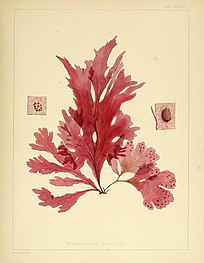 Nitophyllum smithi
Nitophyllum smithi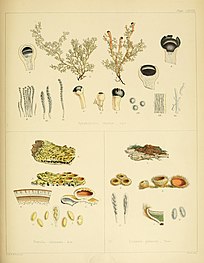
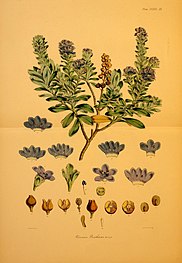 Veronica benthami
Veronica benthami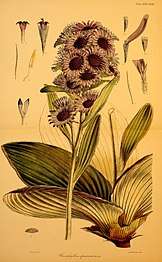 Pleurophyllum speciosum
Pleurophyllum speciosum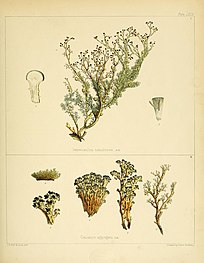 Stereocaulon ramulosum and Cenomyce aggregata
Stereocaulon ramulosum and Cenomyce aggregata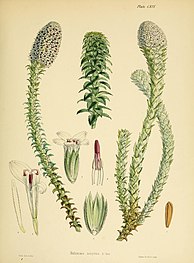 Nafsauvia serpens
Nafsauvia serpens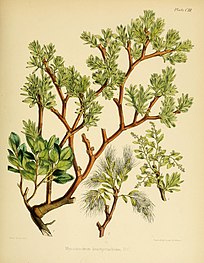 Myzodendron brachystachum
Myzodendron brachystachum
References
- Joseph Dalton Hooker (1844). Flora Antarctica, Volume 1, Parts 1-2, Flora Novae-Zelandiae - The Botany of the Antarctic Voyage of H.M. Discovery Ships Erebus and Terror in the years 1839-1843. London: Reeve Brothers. pp. title pages.
- "The Erebus voyage". Kew Royal Botanic Gardens. Retrieved 28 November 2015.
- Curtis, Winifred M. (1972). Hooker, Sir Joseph Dalton (1817-1911). Australian Dictionary of Biography (Volume 4). MUP.
- David Goyder; Pat Griggs; Mark Nesbitt; Lynn Parker; Kiri Ross-Jones (2012). "Sir Joseph Hooker's Collections at the Royal Botanic Gardens, Kew" (PDF). Curtis's Botanical Magazine. 29 (1): 66–85.
- J.D. Hooker (1844). Flora Antarctica, Volume 1, Parts 1-2, Flora Novae-Zelandiae. pp. v–vii.
- Darwin, Charles. "Letter from Darwin, C. R. to Hooker, J. D. on [5 or 12 Nov 1845] (MS DAR 114: 45, 45b)". University of Cambridge. Retrieved 25 February 2016.
- D. W. H. Walton (28 March 2013). Antarctica: Global Science from a Frozen Continent. Cambridge University Press. p. 7. ISBN 978-1-107-00392-7.
- J.D. Hooker (1844). Flora Antarctica, Volume 1, Parts 1-2, Flora Novae-Zelandiae. pp. 209–223.
- Cave, E. C. (2012). "Flora Tasmaniae: Tasmanian naturalists and imperial botany, 1829-1860 (PhD Thesis)". University of Tasmania. Retrieved 29 February 2016.
- "Hooker, Joseph D. (1817 - 1911)". Australian National Herbarium. Retrieved 29 February 2016.
- Ruse, Michael; Travis, Joseph (2009). Evolution: The First Four Billion Years. Harvard University Press. p. 639. ISBN 978-0-674-03175-3.
- Endersby, Jim. "What Made Darwinism Useful to Joseph Dalton Hooker?". Victorian Web. Retrieved 29 February 2016. Extracted from the conclusion of Imperial Nature: Joseph Hooker and the Practices of Victorian Science, University of Chicago Press, 2008.
External links
- Volume 1 on Archive.org
- Colour Plates on Archive.org
- All volumes at Biodiversity Heritage Library
- Illustrations from 7 volumes: 1, 1(1), 1(2), 2(1), 2(2), 3(1), 3(2)
| Wikimedia Commons has media related to Flora Antarctica (Hooker). |